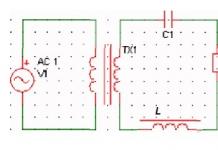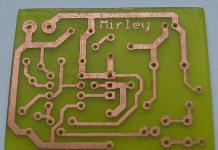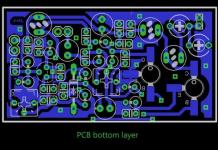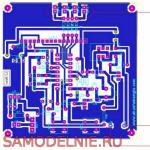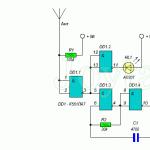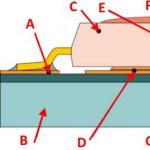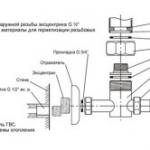Lighting devices, where ultra-bright LEDs are used as light sources, will not surprise anyone. The demand for such devices is constantly growing, this is directly related to the low power consumption of these devices. Given that about 25-35% of the electricity consumed is spent on lighting, the savings will be very tangible.
But given the relatively high cost of ultra-bright LEDs, due to their design features, it is not yet time to talk about a complete transition to this type of lighting. According to experts, this process will take from 5 to 10 years, this is how long it will take to debug and introduce new technologies.
Briefly about efficiency
The efficiency of a lighting device is considered to be the ratio of the generated luminous flux (measured in lumens) to the electricity consumed (watts). A high-quality filament lamp has an efficiency of about 16 lumens per watt, a fluorescent (energy-saving) one four times more (64 lm / W), for long daylight lamps this figure is around 80 lm / W.
The efficiency of ultra-bright LEDs, which are currently mass-produced, is approximately the same as that of fluorescent lamps. Please note that we are talking about mass production. As for the theoretical limit for ultra-bright LED sources, it is defined by a threshold of 320 lm/W.
As many manufacturers promise, in the next few years, the efficiency can be increased to the level of 213 lm / W.
Influence of design features on cost
For the manufacture of ultra-bright LED light sources, one of two methods can be used:
- to obtain light close to white in spectrum, three crystals are used installed in one housing. One is red, the second is blue and the third is green;
- a crystal is used that emits in the blue or ultraviolet spectrum, it illuminates the lens coated with a phosphor, as a result, the radiation is converted into light that is close in spectrum to natural.
Despite the fact that the first option is more effective, its implementation is somewhat more expensive, which negatively affects the prevalence. In addition, the spectrum of light emitted by such a source differs from natural.
Devices made using the second technology have less efficiency. It should also be taken into account that the luminophor contains a complex composite based on cerium and yttrium, which are not cheap in themselves. Actually, this explains the relatively high cost of ultra-bright white light LEDs. The design of such a device is shown in the figure.

Designations:
- A - printed conductor;
- B - base with increased thermal conductivity;
- C - protective case of the device;
- D - solder paste;
- E - LED crystal emitting ultraviolet or blue light;
- F - phosphor coating;
- G - glue (can be replaced by a eutectic alloy);
- H - wire connecting the crystal and output;
- K - reflector;
- J - heat-removing base;
- L - power output;
- M is the dielectric layer.
Mounting Features
The operation of superbright LEDs is affected by the degree of heating of the crystal and the p-n junction itself. The service life of the device directly depends on the first, the level of the luminous flux depends on the second. Therefore, for a long service life of superbright LEDs, it is necessary to organize a reliable heat sink, this is done using a radiator.
It should be appreciated that the thermally conductive bases of these semiconductors generally conduct electricity. Therefore, when several elements are installed on one radiator, care should be taken to ensure reliable electrical insulation of the bases.

The rest of the installation rules are almost the same as for conventional diodes, that is, polarity must be observed, both when installing the part itself and when connecting the power.
Nutrition Features
Given the relatively high cost of ultra-bright LEDs, it is very important to use reliable and high-quality power supplies for their operation, since these semiconductor elements are critical to current overload.
After an emergency mode, the device may remain operational, but the power of the emitted light flux will be significantly reduced. In addition, such an element is likely to cause damage to other jointly connected LEDs.
Before talking about drivers for ultra-bright LEDs, let's briefly talk about the features of their power supply. First of all, you need to take into account the following factors:
- the power of the light flux emitted by these elements directly depends on the magnitude of the electric current flowing through them;
- superbright LEDs are characterized by a non-linear CVC (voltage-ampere characteristic);
- temperature has a strong influence on the IV characteristics of these semiconductor devices.
Below is the change in CVC at a temperature of a semiconductor element (superbright smd-LED) 20 ° C and 70 ° C.

As can be seen from the graph, when a stable voltage of 2 V is applied to the semiconductor, the electric current passing through it changes depending on temperature. When the crystal is heated to 20°C, it will be equal to 14 mA, when the temperature rises to 70°C, this parameter will correspond to 35 mA.
The result of such a difference will be a change in the power of the light flux at the same supply voltage. Based on this, it is necessary to stabilize not the voltage, but the electric current passing through the semiconductor.
Such power supplies are called LED drivers, they are ordinary current stabilizers. This device can be purchased ready-made or assembled by yourself, in the next section we will give some typical driver schemes.
Homemade LED Driver
Let's bring to your attention several options for drivers based on specialized microcircuits from the Monolithic Power System, the use of which greatly simplifies the design. The schemes are given as an example, a complete description of a typical inclusion can be found in the datasheet for the microcircuits.
The first option is based on the MP4688 step-down converter.

This driver can work with voltages from 4.5 to 80 V, the maximum output electric current threshold is 2 A, which allows you to power the lamp on high-power ultra-bright LEDs. The level of electric current passing through the LEDs is regulated by the resistance R FB. The implementation of PWM dimming with a frequency of 20 kHz allows you to smoothly change the current flowing through the LED.
The second version of the driver based on the MP2489 chip. Its compact housing (QFN8 or TSOT23-5) makes it possible to place the driver in the MR16 base used by halogen lamps, which allows replacing the latter with LED ones. A typical MP2489 connection diagram is shown in the figure.

The above circuit allows you to turn on two parallel LEDs, each of which has a working current of 350 mA.
The latest version of the driver based on the MP3412 chip, which can be used in portable flashlights. A distinctive feature of such a circuit is the ability to work from an AA battery.

Now LEDs are used quite often, and in most areas. They are completely different types and differ from each other in many factors. Specifically, in this article we will focus on superbright LEDs. These products are somewhat specific, have their own pros and cons and are used in certain conditions. All questions will be discussed later in the article.
general description
By the name of the product, you can understand that such diodes are sources that give quite bright radiation. They have been developed for situations where conventional standard type tapes are not able to provide the desired level of light. The characteristics of such products make it possible to often use them in cars.
Ultra-bright LEDs are light sources that have special performance and performance properties. The following nuances are inherent in the functioning of such products: the tape is economical, gives a high level of luminescence, has a long service life, and allows the product to be used in various conditions.
You need to pay attention to the fact that often super-bright diodes are produced with a voltage of 12 volts. All sources of this type operate on the same principle. The product has a chip, which is made from a semiconductor material. It is coated with special impurities for more efficient operation. In short: the principle of operation is that the current passes from the anode to the cathode. At the same time, voltage is transmitted in only one direction.
The color of the resulting illumination and the wavelength are determined by how wide the working area transmitting the signal to the components. Silicon and germanium are often used to ease the transition.
LEDs are divided into two types: infrared, ultraviolet. Their list includes models with both a voltage of 12 volts and others. The substrate is sapphire. In addition to this classification, there are several more. Let's look at them in more detail below.

Types of Superbright LEDs
At the moment there is a popular classification of models. Consider what types of superbright diodes are divided into.
- Cree. Products of this type work due to a special composition, which includes gallium nitride and silicon carbide. The combination of their characteristics as a result gives a rather long period of operation of the diode itself. Like all others, this type consumes a little electricity (no more than 12 volts). Often, diodes are used on the street, where it is necessary to illuminate roads, crossings (both underground and aboveground), highways. Moreover, they are often used for lampposts. The chips of these devices are priced quite expensive, as they have a high level of quality. Such ultra-bright LEDs are often used for conventional type flashlights.
- epistar. Diodes of this type are characterized by small dimensions. The quality of the devices is good. They have a long service life. In modern times, they are used almost everywhere.
- smd. Also quite common. Often used for outdoor lighting of a building. They can also be used to illuminate various objects in the room. These tapes are characterized by a dense glow, which is why they have gained popularity all over the world.
Using any of the products described, it is imperative to use special drivers that will allow you to connect them to a 220-volt network. This is due to the low resource consumption (12 Volts). The existing driver will be able to reduce the load so that the product does not burn out.

Advantages
In a short amount of time, ultra-bright and other diodes have become quite popular and in demand in various fields. The reason lies precisely in the advantages, which we will now consider.
- Energy efficient products. Among all available light sources, this type is considered the most economical. As a rule, the use of diodes can reduce electricity demands by up to 80%. The ultra-bright white LED consumes the most compared to the rest.
- The product is able to work for a long time without requiring special maintenance or routine inspection.
- The diode is not very selective with regard to temperature. Therefore, you can use it in any conditions.
- If you need a light source that is protected from moisture and can withstand shock, then among the super-bright diodes there are such models.
- During operation, the product does not heat up. The only thing to keep an eye on is the power supply. It is he who takes all the load on himself and heats up.

Flaws
The parameters of the products are quite good and profitable. However, it must be taken into account that there are also disadvantages. Which?
- Due to the fact that the conductivity of light deteriorates over time, the brightness of the radiation decreases.
- If the process of changing the signal strength is performed, then the chip may burn out. Such situations do not occur very often, but there is a possibility of a breakdown.
- Diodes are still susceptible to excessively high temperatures. To what indicators of heat - you need to find out specifically in relation to the purchased model.
- In order for the diode to work, it is necessary to install a special radiator.
- If the product is used in an open space, it will be necessary to provide additional protection against moisture, dirt, and damage.

Scope of use
Now super-bright diodes are widely used in the industrial field, advertising, household and as a backlight on various vehicles. As for household appliances, we are talking about the glow of LCD technology and other objects. Also, the most famous example of the use of this product is a traffic light. Ultra-bright LEDs are the most popular light source for cars.
Even with the existing shortcomings, proper installation is enough to reduce the disadvantages to a minimum. As you know, this product is used quite a lot and often, so we have to talk about its indispensability. Such a diode can easily create the desired level of light in the house or on the street. The main thing is to choose the right model.

Super bright LEDs - characteristics
The most important and defining characteristic can be called the operating current. Due to the fact that the diodes operate on a constant resource, its excess can lead to a breakdown of the entire structure. The average value of a super-bright product is 15-20 mA. The current of one of the most powerful diodes can reach 1 A.
Ultra-bright LEDs have different voltages. It, depending on the model and purpose, can range from 1.5 to 4 V. As a rule, it is this indicator that affects what color of the radiation is the result. For example, a low voltage produces infrared (1.5 V), while a higher voltage achieves white (3.7 V).
The average power for fairly strong diodes is 1 W, for standard products - 0.3 W.
Super-bright products are sold in various colors. The stores have amber, orange, blue, green, red and white models. The latter option can be found in three different shades: cool, warm and medium.
Mounting Features
In order for ultra-bright LEDs to work for a long time and give out bright light constantly, it is necessary to organize a heat sink during installation. This can be done with a radiator. Due to the fact that the base of the diodes, made of semiconductors, is capable of conducting current, care must be taken to create electrical insulation. The basic processes are the same as for the installation of conventional products, so problems should not arise.
Outcome
Ultra-bright diode tapes are able to create powerful lighting with minimal electricity consumption. Due to this, it is possible to solve the issue of a very large expenditure of funds to pay for the consumed resource. Today, ultra-bright LEDs are important, indispensable and significant sources that will easily create the right lighting in any conditions.
Today, LEDs are used in many areas of human activity. They are the most varied. But today we will talk about such a variety of them as super-bright LEDs.
Such products have their own specific characteristics, advantages and disadvantages, which will be discussed in our article.
Description
Ultra-bright types of diodes are a light source that gives super-bright light. They were developed due to the fact that LED strips of a standard plan can not always provide the desired level of light.
Note! This ultra-bright type of product is very often used for cars.
Ultra-bright LED strip is an ultra-bright light source that has specific parameters and performance characteristics. This product has the following operating parameters:
- economy;
- high rates of light emission;
- durability of crystals;
- the ability to use the product in any conditions;
- minimum power consumption.
Note! Very often used models with a voltage of 12 volts.
Any super-bright light source has the same principle of operation. Ultra-bright types of diodes consist of a chip made from a semiconductor material. The chip itself is doped with impurities to create a p-n junction. This structure is typical for smd and cree models.
The principle of operation here is based on the flow of current from the p-side (anode) to the n-side (cathode). In this case, the voltage transfer is carried out in one direction.
Such diodes have a design shown in the photo below.
Superbright diode design
The color and wavelength of the light emitted by the product is determined by the width of the working area, which transmits the signal to the materials that form the p-n transition. Very often, germanium and silicon are used to create this transition.
The super-bright type of LEDs (at 12 volts or with a different voltage) is of two types:
- infrared;
- ultraviolet.
For them, sapphire is often used as a substrate. But besides this gradation, there is another classification.
Product types
Today, products of such a plan are divided into the following types:
- epistar. These are high quality diodes with compact dimensions. They are characterized by a long period of work. They have extensive use in the modern world;

Epistar - high-brightness diode

Cree - ultra-bright type diode
- Cree. Such diodes function on the basis of gallium nitride and silicon carbide. And their characteristics are distinguished by a long period of work. In addition, cree, like other models, consumes a minimum of electricity (12 volts). Cree LEDs are most commonly used to illuminate underpasses, pedestrian crossings, roads and highways. Very often, cree is used in hand and street lamps;
Note! This type of lighting products is characterized by excellent quality, which is why they are more expensive than other models. The 3528 and 1210 chips are slightly cheaper, but have a lower light output.

Smd - superbright type diode
- smd. Also a fairly common type of super-bright LED products. Smd models are widely used in a wide variety of areas of human activity. Especially often smd diodes are used to illuminate buildings from the outside, as well as create high-quality interior lighting inside buildings. SMD LED strips are characterized by a dense glow, which made them so popular and in demand in the modern world.
When using this kind of products, regardless of the type, it is always necessary to use drivers to connect their 220 volt AC mains. This is due to the fact that most often products of such a plan are produced at 12 volts. A special driver (power supply) will lower the voltage from 220 to 12 volts. This must be taken into account when purchasing a product and additional equipment for it, as well as when installing lighting.
Advantages and disadvantages
In just a few years, LED light sources, including ultra-bright and conventional diodes, have become very popular. The reason for this lies in the following benefits obtained by installing them:
- energy efficiency. These are the most economical light sources in terms of power consumption. When using such products, it is possible to save up to 80%;
- long period of service;
- no heat during operation. Here it is necessary to take into account that the most heated element in the circuit will be the power supply;
- can function normally over a wide temperature range;
- the presence of impact resistance and moisture resistance (if necessary).
As you can see, the parameters of the operation of such devices are very beneficial. But besides the advantages, there are some disadvantages:
- for outdoor use, additional protection against moisture, dust and mechanical damage is required;
- the need to install a special radiator;
- sensitivity to very high temperature;
- the possibility of breakdown when the signal strength changes;
- as time passes, the light conductivity decreases and the brightness level decreases.
Today, due to the obvious advantages of such light sources, they are widely used in:
- industry;
- advertising field;
- domestic sphere (LCD technology backlighting, internal and external lighting of objects of various types, etc.);

Home illumination
- as lighting on vehicles.
As you can see, despite the abundance of advantages, there are still certain disadvantages. With the right approach to installation, some of them can be leveled. The use of ultra-bright LED products will allow you to create the necessary level of illumination anywhere in the house or street.
 How to choose outdoor metal halide spotlights
How to choose outdoor metal halide spotlights
 Halogen incandescent lamp - what you need to know when choosing
Halogen incandescent lamp - what you need to know when choosing
 Organization of kitchen spot lighting, pros and cons, design options
Organization of kitchen spot lighting, pros and cons, design options
At the dawn of the era of LEDs, even a slight glow of an element seemed like a breakthrough, because even several pieces combined together practically did not consume energy. Time passed, and with it similar products developed. Today, you will not surprise anyone with super-bright LEDs, which have become used everywhere. But despite their prevalence, people know little about such LED elements. Today's article will correct this omission.
High brightness LEDs: general information
Such elements can be formally divided into 2 categories. Some have increased power, others are designed in such a way that, with low power consumption, they are able to produce a luminous flux that is several times greater than that of conventional counterparts.
One of the representatives of such ultra-bright LEDs are Cree products. The cost of such chips is quite high, which leads to the emergence of many fakes. Chinese manufacturers are especially distinguished in this field. Often, their products at first shine even brighter than the original, but the fake quickly degrades. After 10-15 hours of continuous operation, the diode dims down to complete failure.
If we talk about SMD components, then among them you can also find super-bright LEDs, but their power consumption will be much higher, as well as the dimensions. But elements of small sizes can be found under the Epistar brand. Pretty good quality and long service life - these are the reasons for the popularity of these LEDs.

Types of similar elements and their characteristics
In the manufacture of such LEDs, certain semiconductors are used. If we divide them by type, we can distinguish 2 main ones:
- AlInGaP - elements of yellow, green, orange and red colors are made from it.
- InGaN - white, blue, green and blue-green LED elements.
The characteristics of ultra-bright LEDs allow them to be used in completely different areas. They are used to illuminate workshops, streets, apartments. Such elements are also installed on cars as daytime running lights, dimensions or low beam headlights. However, the latter option is increasingly losing popularity.

The fact is that ultra-bright LEDs get very hot during operation. After they are installed in the headlight housing, they have to work almost constantly, which leads to an increase in temperature and rapid degradation. But as dimensions, which are included only at night, when it is much cooler outside, they have proven themselves well.
But the most common area of application for ultra-bright LEDs can be called lights. Such a device with elements installed in it, for example Cree, is capable of penetrating the darkness with a beam at a distance of up to 2-3 km. At the same time, its power consumption will remain at a fairly low level. Most often, forehead options are used by fishermen when fishing at night - the light flux reaches the bottom through a water column of 3-4 meters.

Application of LEDs in the automotive industry
Not all LED elements are suitable for cars. Many types need only 2-3 V power, while the on-board network of the car needs 12 V. That is why the manufacturer offers specialized LED elements for cars. The main thing here is to understand where you can put super-bright 12-volt LEDs, and where they should not be mounted. After all, if such elements are on the brake lights, it is likely that they will blind the driver of the car coming behind, and this will not lead to anything good. Also, you should not install them in the backlight of the panel - it will be impossible to drive at night with such “tuning”.
It is acceptable to install super-bright LEDs at 12 volts in reversing lights, dimensions, and also as interior lighting. In these cases, the installation of such equipment will be justified. It is possible to include LEDs in the circuit as a low beam, but in this case, it is necessary to organize high-quality air cooling. An example of this use of ultra-bright elements are Lexus cars.

Operating voltage of LED elements
Many people give too much importance to this parameter, not understanding its essence. The point here is this. If, for example, it is written that the rating of a super-bright LED is 3 volts, this figure means only the voltage drop across it. A more important parameter is the operating current of the element, which can reach 1 A.
What to consider when choosing and installing
When choosing super-bright LEDs for cars or other applications, you should pay attention not only to the characteristics declared by the manufacturer, but also to the appearance of the product, the quality of its manufacture. Often a fake can be detected even with a visual inspection with the naked eye. Counterfeit LEDs may have uneven edges, the chip under the lens is often asymmetrical.

The underestimated cost in comparison with the average market should also alert the buyer. Before going to the store, it is better to familiarize yourself with the prices on the official websites of manufacturers of such products - this will save you from purchasing low-quality goods.
The installation of ultra-bright LEDs also requires compliance with certain rules. Even with good ventilation, if there is a possibility of an additional radiator, it is worth doing. Thermal paste should be used to connect the chip to the cooler.
Pros and cons of using super-bright elements
Like any equipment, such LEDs have supporters and opponents. According to surveys conducted by an independent company, about 30% of respondents were "against" the use of such LED elements. The most interesting thing is that the reason for the emergence of a negative attitude was the use of super-bright LEDs for flashlights. People said that it is very harmful when such a beam shines into the eyes. A strange opinion came from the inhabitants of the United States of America, where polls were conducted on this topic.

Basically, the use of such elements in lighting fixtures has more positive than negative qualities. Of course, if you purchase a high-quality, branded product, its cost will be high, however, it will last much longer than a low-grade cheap diode. The main thing in this matter is to compare your capabilities with the level of need for such an acquisition.
Summarizing the above
Ultra-bright LEDs are truly the pinnacle of LED-element development today. Do not complain that their cost is quite high. Like any other devices, they will fall in price over time. Although it is possible that engineers will develop some other novelty that will outshine the ultra-bright LED. Based on the pace of progress in all technical areas, this cannot be ruled out.
Founded in 1987 in the United States of America (USA), Cree has embarked on the creation of semiconductor devices based on silicon carbide (SiC) and gallium nitride (GaN). Joint work with Japanese colleagues contributed to the rapid development of new technology and, as a result, the appearance of the first high-power LEDs of the XLamp series. In 2006, the developers took the milestone of 100 lm/W, in 2010 - 200 lm/W, and in 2012 - 250 lm/W, having overcome the next theoretical maximum for crystals of this type. Today, Cree manages to regularly prove to theorists the inexhaustible possibilities in improving solid-state light sources.
In addition to the world-famous XLamp, the American corporation holds a leading position in the production of low-current, super-bright High-Brightness LEDs, which are no less in demand in the design of electronic equipment. Cree products are not limited to light emitting diodes. Her laboratories successfully implement projects to create high-voltage Schottky diodes and microwave field-effect transistors.
Powerful LEDs
With several pioneering discoveries over the past 5 years and introducing new models of LEDs and COB LED arrays to the world, Cree continues to improve the power and efficiency of its products. The first group of LEDs is represented by powerful samples of the XLamp series, which consists of several families that differ in production technology, form factors and some technical parameters. In the XLamp series, two large groups of light emitting diodes can be distinguished: single-chip and multi-chip.
Single-chip
Cree single-chip LEDs are the smallest members of the XLamp family. Possessing a high density and luminous intensity, the geometric dimensions of XQ series LEDs are 1.6x1.6 mm. LEDs of this series have changed the idea of a standard light distribution pattern, directing it closer to the edges. This innovative approach makes it possible to implement luminaires with a wide beam angle using fewer LEDs. The angle of illumination of XQ series LEDs is in the range of 100–145°. One of Cree's latest developments is XQ-E High Intensity LEDs. American engineers managed to squeeze a power of 3 W out of a tiny crystal, converting it into a luminous flux of 334 Lm.
The entire line of light emitting diodes, built on a single chip, has excellent color rendering (CRI 70-90).
Multichip
Having reached the mark of 3000 mA, manufacturers of solid state light sources began to increase power by increasing the voltage. The American company Cree has achieved great results in this direction, offering the world new standards for LED supply voltage. Cree offers several series of multi-chip LEDs rated from 6 to 72 volts. All multi-chip SMD white LEDs from Cree can be divided into three large subgroups: high-voltage, power up to and above 4 watts. Separate subgroups of multichip light emitting diodes include powerful COB matrices, color and Royal Blue LEDs.
Up to 4 W
 The line of LEDs on several crystals, with a total power of up to 4 W, is represented by 6 light-emitting diodes in cases: MX and ML. According to their technical parameters, they are united by a luminous angle of 120° and two possible color shades: cold and warm white. The MX series has found a compromise between light output and power consumption. By increasing the supply voltage, the developers managed to achieve high reliability without reducing the quality of light.
The line of LEDs on several crystals, with a total power of up to 4 W, is represented by 6 light-emitting diodes in cases: MX and ML. According to their technical parameters, they are united by a luminous angle of 120° and two possible color shades: cold and warm white. The MX series has found a compromise between light output and power consumption. By increasing the supply voltage, the developers managed to achieve high reliability without reducing the quality of light.
LED series ML and MX is positioned on the market as devices with an average price cost.
Over 4 W
Not resting on its laurels, Cree continued the "lumen race" and presented a new generation of multi-chip LEDs with a power of more than 4 watts. Crystals of the MT-G series are the largest representatives of the group, have a power of up to 25 watts.  A novelty from Cree is the XHP (Extreme High Power) LED series, which is represented by 4 models. The largest representative is made in a 7x7 mm case and, consuming 12 W, gives out 1710 lm. The advent of XHP gave impetus to the development of new lighting designs with lower costs for secondary optics and cooling system.
A novelty from Cree is the XHP (Extreme High Power) LED series, which is represented by 4 models. The largest representative is made in a 7x7 mm case and, consuming 12 W, gives out 1710 lm. The advent of XHP gave impetus to the development of new lighting designs with lower costs for secondary optics and cooling system.
High voltage supply (12-46V)
Cree's HVW (High-Voltage White) LEDs are a tandem of huge light output and small package size. Having compact dimensions, they surpassed LED assemblies by an order of magnitude, due to which they began to be used in the production of retrofit lamps. Lamps with an E14, E27 base based on HVW have a high efficiency, smaller dimensions of the driver and radiator than their counterparts on low-voltage light emitting diodes. 
colored
In parallel with the modernization of white LEDs, Cree is expanding the potential of color LEDs, which are in demand in decorative interior lighting, architectural outdoor lighting and artificial plant lighting. With a wide choice of colors, the XP-E series features a high light output in a 3.45x3.45mm housing. The XQ-E series has even smaller dimensions of 1.6x1.6 mm, which attracted the attention of growers. The XQ-E HI's compactness and lack of a domed lens provide the targeted beam of light required for efficient greenhouse plant growth. The MC-E RGB+W and XM–L RGB+W series LEDs feature adjustable color temperature and brightness, as well as cool white light capability. 
Cree's XLamp Royal Blue LEDs are classified as a separate group due to their design features, namely, "remote phosphor" technology. Its essence lies in applying the phosphor not to the crystal, but to the inner surface of the secondary optics. The result is a highly efficient beam of light with a narrow "deep blue" emission spectrum. Production of XLamp Royal Blue is carried out in standard XP, XR, XQ, XB, XT, ML cases and is characterized by lower cost. 
COB (Chip-on-Board) technology continues to improve, increasing power through improved technology and increased LED density. Cree's COB line is represented by the CXA and CXB series. The size of the largest CXA matrix is 34.85x34.85 mm, and its luminous flux is 12,000 lm. The improved CXB dies are made on the new CS5 platform, but are fully interchangeable with the CXA. For example, the specialized CXB 3590 Studio LED is a new generation of the COB line with a CRI index of more than 95, designed for building photographic equipment. 
High-Brightness LEDs
Super-bright Cree LEDs make up the second large group - High-Brightness, whose representatives are distinguished by a low current value from 20 to 70 mA. There are 4 lines of LEDs in the group, which differ in execution. Thanks to this unification, manufacturers are able to design structures of different form factors and purposes.
PLCC
Cree's PLCC line consists of LEDs designed for surface mounting. Regardless of the color of the glow, they are collected on one or more crystals. The line includes a wide range of light emitting SMD diodes of different colors and sizes. Among the new products, it is worth highlighting the CLYBA-FKA RGB diode in the PLCC-6 package, which is used in the formation of a scoreboard with a running line.
P4
 The next representative of super-bright LEDs is SuperFlux, better known as Piranha. Square-shaped epoxy resin housing with concave, convex or oval lens evenly distributes the light flux at a given dispersion angle. Four metal pins ensure secure fastening in high vibration conditions. LED P4 from Cree is installed in searchlights, car signal lights, etc.
The next representative of super-bright LEDs is SuperFlux, better known as Piranha. Square-shaped epoxy resin housing with concave, convex or oval lens evenly distributes the light flux at a given dispersion angle. Four metal pins ensure secure fastening in high vibration conditions. LED P4 from Cree is installed in searchlights, car signal lights, etc.
Round
 Cree's new generation of round, low current LEDs provide superior light output. Their body is made of optical epoxy resin with a diameter of 5 mm. The current consumption is only 20 mA. Colored round LEDs have several modifications, different in light intensity and glow angle. White C535A-WJN and C503D-WAN are available without stoppers, other models are equipped with pin stops.
Cree's new generation of round, low current LEDs provide superior light output. Their body is made of optical epoxy resin with a diameter of 5 mm. The current consumption is only 20 mA. Colored round LEDs have several modifications, different in light intensity and glow angle. White C535A-WJN and C503D-WAN are available without stoppers, other models are equipped with pin stops.
oval
 The production of oval LEDs is focused on the creation of LED screens of large dimensions, which is in demand when creating billboards all over the world. Cree oval LEDs are 4mm in size. Their unique design allows light to be emitted in two directions: along the X-axis and along the Y-axis, as shown in the technical specifications. Along with round counterparts, they are designed for a current of 20 mA, resistant to sunlight, temperature and humidity changes. Oval LEDs have a lower luminous intensity due to the large scattering angle.
The production of oval LEDs is focused on the creation of LED screens of large dimensions, which is in demand when creating billboards all over the world. Cree oval LEDs are 4mm in size. Their unique design allows light to be emitted in two directions: along the X-axis and along the Y-axis, as shown in the technical specifications. Along with round counterparts, they are designed for a current of 20 mA, resistant to sunlight, temperature and humidity changes. Oval LEDs have a lower luminous intensity due to the large scattering angle.
The American company Cree provides more than three-quarters of the world's demand for silicon carbide, suitable for the production of semiconductors, including LEDs. Having a full production cycle from growing crystals to creating lamps, the corporation is directly or indirectly involved in the technical re-equipment of lighting systems of many enterprises in the world.
Reducing the cost of high-power LEDs and reducing the interval between development and serial production are two indisputable facts confirming the reliability of cooperation with Cree. The company operates in accordance with the RoHS directive, which limits the content of harmful substances in products supplied to the market.
Read also
